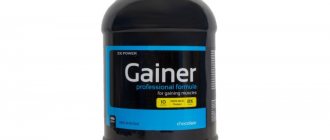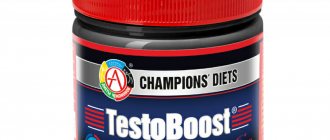The number of workouts per week is calculated individually for each person. It depends on a person’s physical activity, his workload, the goals he pursues, and of course, his state of health. The article will outline recommendations for a healthy person with an average workload.
The optimal frequency of training is most often determined by the main purpose of visiting the gym. It is this factor that affects how many days our body needs to recover. Let's see how many times it's better to train per week. Training frequency is determined by the number of workouts of a given muscle group or lifts per unit of time.
We recommend reading: Chest press on a machine
How often to train a muscle group[edit | edit code]
Muscle Training Frequency
Many people wonder how often a muscle group should be trained to achieve maximum muscle growth? Opinions are very polar, some argue that the optimal frequency of training one muscle group is no more than once a week (for example, the super training system), otherwise you will overtrain and not recover, others cite the example of lifters and weightlifters who squat 2-5 times per week and growing.
A meta-analysis on this topic was published in 2021. Ten studies published in English-language peer-reviewed journals were analyzed, comparing different training frequencies in traditional dynamic and eccentric movements, a minimum duration of 4 weeks, and participants without chronic diseases or injuries.
Conclusions:
Statistical processing of the results showed that the frequency of training significantly affects the amount of muscle hypertrophy, with a higher frequency associated with a more pronounced effect. When compared to studies that compare training a muscle group 1 to 3 times per week at the same training volume, current evidence suggests that training 2 times per week results in greater hypertrophy than training once per week.
We can confidently say that the main muscle groups need to be trained at least 2 times a week for maximum growth
. At the same time, we cannot yet say that three workouts a week will be better than two.
How to avoid overtraining?
This is an equally important topic compared to how often to exercise. First of all, you need to monitor your progress. If you stop progressing in at least one exercise, this may indicate that you are close to overtraining.
In the example we considered above, this is what happened, because the builder noticed that he had stopped improving his results in the bench press. If a similar situation happened to you, then you should rest. Here are the three main symptoms of overtraining.
We recommend reading: Bench leg press
- The working weight in exercises does not increase. To progress, you need to gradually increase the load. However, for this, the body must fully recover so that you can work with heavy weights.
- The number of repetitions or the time of static holding of projectiles does not increase. If the working weight does not increase, then the number of repetitions or the time of static holding of the projectile should increase.
- You spend more time doing the same workout. The effectiveness of training is closely related to the concept of intensity, which is measured in units of time. Simply put, if it took you longer to do an activity you did a few days ago today, then the intensity has dropped.
Periodization of training[edit | edit code]
The principle of planning the frequency of training
The frequency of training in bodybuilding is categorically different from periodization in any other sport. Because, firstly, at different stages the athlete is given two directly opposite tasks: to gain weight and to lose weight. They can be combined into one cycle, but it is better to separate them. In addition, preparing for competitions is not just banal weight loss, it is an attempt to reduce the amount of fat and water in the body to an absolute minimum. In this case, it is necessary to achieve uniform development of muscle groups, “correct” (by available methods) proportions, etc. and so on. The training parameter in bodybuilding is muscle volume. Strength is not taken into account; it is viewed rather as a “by-product” of mass training. The increase in muscle volume itself can proceed along two main paths: hyperplasia (increase in the number) of muscle fibers and hypertrophy (growth in their cross-section). Here it should be taken into account that there are at least two different types of fibers; in general, training should be built on the assumption that there are three of these types. The tasks are non-trivial, it will not be possible to combine them even with all the great desire, which means that we need to approach their solution consistently. It is this sequence of solving diverse problems that constitutes the essence of periodization in bodybuilding. Moreover, not only the fact of how often you train, but also diet and pharmacological preparation have its own characteristics.
If we talk about diet during this period of time, then the calorie content of the diet should exceed your energy expenditure. This is the only thing that unites the mesocycles of work on hyperplasia and hypertrophy. It is from this that it becomes clear how often you need to train.
Hyperplasia[edit | edit code]
The main feature of this period is the use of such a pharmacological drug as insulin-like growth factor. That’s right - we adjust everything else to this drug. Duration - 4-6 weeks. It is this duration of this period that, in my opinion, is optimal. This is explained by two factors: After 6 weeks of use, the effectiveness of any training program decreases sharply. The optimal duration of use of IGF-1 is exactly 6-7 weeks.
Training at this time is a “rabid” “pumping”. However, only 3 sessions per week can be devoted to this type of training - on the days of IGF-1 injections. You can “get” another 1-2 sessions, say, through plyometrics or “explosive” repetitions (see below). An important feature of “pumping” is that it will significantly increase muscle density. That is, the period of working on hyperplasia will also be a period of working on muscle density.
Of the pharmacological drugs, in addition to IfR-1, it is worth leaving in your arsenal only testosterone, to which you can add (or not add) nandrolone or anadrol or methandrostenolone. It must be said that some of the testosterone injections should be carried out not into the gluteal muscle, but into the group that was subjected to training the day before or will be training soon (if these are the arms, then injections can be done into the deltoid muscle, legs - the outer part of the quadriceps; do injections into the muscles of the back or chest are not necessary - systemic ones can be used).
Hypertrophy[edit | edit code]
This period should ideally immediately follow the period of hyperplasia. Its duration is the same as the period of work on hyperplasia, that is, 4-6 weeks. Here, significant changes are made to the training process, and the pharmacological drugs used also change.
In fact, we move on to strength work, that is, we try to use the maximum weights with which we can handle 5-8 repetitions per set. The duration of rest between sets is slightly increased, methods of intensifying the training process such as supersets (trisets and giant sets even more so), drop sets and others like them are completely excluded. As for “pharma,” as you probably already guessed, IGF-1 is not used during this period. As for me, it would be justified to introduce insulin and dexamethasone into your “diet”; from AAS, the main bet should be on the same testosterone, adding trenbolone and oralturinabol to it (this is if the latter now existed in nature).
Volume training[edit | edit code]
I do not consider it necessary to allocate my mesocycle for this type of training, but for fans of “volume” it is quite possible to do it after working on hypertrophy and just before returning to the “hyperplastic” mesocycle. What are the goals of volume training? All the same - growth in the cross section of the muscles. But it will happen mainly due to an increase in the amount of sarcoplasm. Okay, I agree, this is also important, so a volumetric mesocycle can be planned.
If you decide to train for volume, then the optimal cycle duration is 3-4 weeks. I will not present the principles of this training system here; we have written about them more than once. For the uninitiated, volume work is work in which one exercise is performed per muscle group - in 10 sets of 10 repetitions each. You can do one additional exercise (3 sets of 10 repetitions). During a workout, two muscle groups are “pumped up”.
In fact, volume training is a rest, first of all, for the nervous system - nevertheless, the central nervous system is subjected to significant stress while working on hypertrophy. And we really need such a rest, even if we ignore the other “charms” of the “volume” (well, I agree: another argument in favor).
The arsenal of pharmacological agents during volume training is almost the same as in the previous case.
Working on different types of muscle fibers[edit | edit code]
It is hardly worth dedicating a separate mesocycle and even microcycle to working on types of muscle fibers that are not your main ones. It would be more logical to integrate such training into your regular microcycle. For example, you can plan to train slow fibers during the mesocycle dedicated to hyperplasia. Fast-twitch muscle fibers need to be trained during the “hypertrophic” mesocycle, although it would be better to devote 1-2 days to plyometrics or “explosive” training during the period when new fibers of this type will be formed, that is, in the “hyperplastic” mesocycle.
How long should I spend in the gym to get pumped up?
The question is obviously incorrect, since the type of physical activity and its intensity are not taken into account.
For example, a tough CrossFitter Workout can knock you down in eight minutes so that even an experienced athlete will not be able to pull himself together all day. In turn, the training of weightlifters and powerlifters, when they work with weights up to 90-95% of the one-repetition maximum, or even reach their peak, can last 2-3 hours or more.
In the first case, there is no rest between exercises, and you actually plow for 8 minutes without a break in a mode that is prohibitive for the body. And in the second case, the athlete squeezed a huge weight a couple of times in a few seconds, after which he rests for 6-8 minutes before the next approach (this is necessary to restore the central nervous system; the energy reserves of the muscles are completely restored in 2.5-3 minutes).
If we talk about fitness and bodybuilding, then a similar dilemma arises regarding the duration of the workout. Especially if you are interested in visible results, and not just spending time in the gym.
How much do local instructors usually advise? 60 minutes no more, and then “terrible catabolism” begins, “muscles are destroyed” and other nonsense.
I don’t argue, sometimes an hour is really enough and we’ll talk about this below. But in reality, the roots of this fable grow from the standard duration of a paid training session with the participation of a trainer. It is the same 60 minutes. And then the fitness instructor has the next client, and you “will begin to go into catabolism if you keep on top of my ears and demand that the banquet be continued.”
You can also turn to history and remember the crazy 3-4 hour workouts of bodybuilders of the golden era.
Arnold Schwarzenegger, in preparation for Olympia, usually trained six days a week for 3-4 hours daily, and sometimes it was a couple of workouts a day with a similar duration each. He looked great.
In turn, Mike Mentzer developed and successfully demonstrated his own “V.I.T.” system. when the duration of one workout did not exceed 45 minutes, there were no more than four or five such workouts per week and each muscle group was loaded no more than once every 6-7 days. And he showed no less impressive form than “Iron Arnie.”
The same system was used by Dorian Yates , a six-time winner of the Mr. Olympia competition.
And where is the truth here? You can, of course, say that such athletes were “charged” with pharmacology to the very eyebrows and there, no matter how you train, you will still grow. But in this regard, I already wrote above that this kind of drugs actually gives. And if everything is so simple, then there would be solid athletic handsome men and beauties walking around. In reality, there are only a few people who truly stand out physically.
This was an introduction and a little theory, now let's look at it from a practical point of view.
How often to train for relief[edit | edit code]
The number of muscle fibers with restored functional integrity after injury.
The assessment was carried out by recording action potentials in individual fibers after stimulation of the muscle on the uninjured side. C—control (undamaged) muscle. Open circles are averages (Stuart, McComas, Goldspink and Elder. 1981) The main parameter that is subject to dramatic change during this period of time is the caloric content of the daily diet. If you are faced with the task of getting rid of excess subcutaneous fat, then your daily energy expenditure should exceed what you get from food. How big the difference will be depends on the timing of preparation for the competition.
The usual training period for an average level athlete is 2-3 months. Although there are those who can easily get themselves into competitive shape in 1-2 weeks. But this is an extreme case and is hardly worth taking seriously. Usually, at the very beginning of the preparation period, restriction of carbohydrates in the diet begins; as a rule, for a certain period of time, the athlete resorts to a carbohydrate-free diet. How long should a “no-carbohydrate” diet last, is it worth resorting to carbohydrate alternation, etc. - questions that are beyond the scope of this article. We will remember for now: the main difference between the period of working on the relief is limiting the caloric content of the diet. However, one of the interesting preparation options is the following: the athlete loses weight as much as possible, and the period of preparation for competitions coincides with the period of gaining muscle volume. It is clear that in this case there will be no talk about any restriction of calorie intake (only carbohydrate alternation is possible in the later stages of training), in general, the task comes down to the “typical” one, that is, working on muscle volumes. Kevin Levrone usually prepared according to this scheme, Gunther Schlierkamp used it in the last years of his performances, and Dexter Jackson often used this scheme. The main advantages of this scheme: Catabolic processes are minimized (aerobic exercise is practically eliminated), there is no threat of loss of muscle mass.
From the very beginning of preparation, you can see which muscle groups need to be “tightened” and what should be worked on first. But let's return to the typical “drying”. As for training during this period, it is very difficult to give clear recommendations. The key is to avoid falling into a catabolic hole, which means you shouldn't exercise too often. For some, training with heavy weights is most suitable, for others, they rely more on the volume of the training process, for others... One of the possible options for constructing the training process is given in the article by Yuri Spasokukotsky “Training while working on the relief” in the same issue our magazine. Here I just want to mention two features of training during the “drying” period: It is mandatory to include in the training process either aerobic exercise, or interval training, or aerobic strength training (the latter, in my opinion, is most preferable). It is likely that special attention will have to be paid to 1-2 lagging muscle groups, the lag of which will become more and more obvious as you get rid of the subcutaneous fat layer.
PHARMACOLOGICAL DRUGS.
During this period, everything is used that can have one or another effect on fat burning - be it by “spinning up” metabolism (triiodothyronine, DNP), increasing thermogenesis (caffeine, ephedrine), enhancing the release of fatty acids from fat “depots” (metformin) or switching the body to use fat as the main source of energy (clenbuterol). In principle, fat burners from the world of sports nutrition will do the trick at first, but pharmacological drugs are much more reliable and effective. If we talk about hormonal drugs, their selection is very sophisticated. As a rule, those that may contribute to water retention are excluded from consideration. Although, with reasonable use, good results can be obtained even with a drug such as Sustanon-250, despite the fact that it will be almost the only AAS on the “course”. During the preparation period for competitions, the use of growth hormone is mandatory - mainly due to its anti-catabolic and powerful fat burner properties. However, recently, your humble servant has become more and more inclined to believe that the use of IGF-1 is more preferable. Moreover, participation in the “process” of growth hormone becomes completely optional. Thus, insulin-like growth factor will allow, to some extent, in the 2-3 week period before the start, to imitate the work of DNF, while allowing you to train hard. IGF-1 is an excellent fat burner; its daily use for 10-12 days will allow you to “squeeze” glycogen out of the muscles as much as possible; stopping taking this drug will mean the beginning of a gradual filling of the “depot” with glycogen (the filling process, as practice shows, reaches its maximum on 7-8 days after discontinuation of IGF -1).
What determines the duration of training and what it should be?
If you are a beginner , then you obviously start with full-body workouts and first learn the technique of doing the exercises. Usually these are 8-10 exercises, which take about an hour and a half due to the small weight of the burden. This length of training is normal. Gradually the weight of the weights increases, and the workout can last even two hours , which is also ok.
For beginners, the normal mode of work is three strength training sessions per week for the whole body with a rest between them of a day or two and lasting one and a half to two hours each .
Muscles that begin to burn after an hour of intense work are unproven nonsense. They don’t burn and you have more or less enough energy, provided that one and a half to two hours before training you refuel with normal food (proteins + carbohydrates + fiber) or drink at least a good portion of protein 40-60 minutes, if you didn’t have time to do so eat.
Alternatively, if not for fat burning, you can use isotonic drinks with a small amount of glucose, BCAA or energy cocktails made from amino acids (such as ON Essential Amino Energy). They perfectly keep you in good shape during long workouts or especially difficult ones (on leg day, for example).
As for the number of strength training sessions for beginners , the ideal is three per week with a break of a day or two between them. The classic version is Mon-Wed-Fri or Tue-Thu-Sat. Yes, yes, you can easily work in this mode, pumping your entire body three times a week and spending one and a half to two hours on each workout. Moreover, you will also have enough cardio between strength training.
This is personal experience (I arranged several such FullBody cycles for myself) and the experience of the people with whom I worked. It is important here that the training program is designed intelligently and that the load increases very smoothly and carefully.
Simply put, the average duration of a workout of one and a half to two hours is normal and will not harm your body in any way, but will only help you become stronger and more beautiful. Provided that we are talking about the classic mode for 8-12 repetitions with a rest time between sets of 1.5-3 minutes. But there are special cases.
A strength-focused workout can last three hours or more.
For example, training with an emphasis on strength development . This is working with heavy weights up to 90% of the one-rep maximum for 3-6 repetitions. Rest between approaches in this mode can reach 10 minutes, but on average it is at least 5 minutes. And by the time you reach your peak load, you will spend a lot of time warming up with intermediate weights. The duration of such training can reach three hours. This is also normal and natural.
It is unnatural and abnormal to try to cram a strength training session into 60 minutes and try to lift heavy weights without resting the central nervous system and without replenishing the ATP and creatine phosphate stores in the muscles. In this case, you simply will not work 100% and will simply waste your strength training.
By the way, this is precisely the mistake that most people make who want to mindlessly follow popular advice - in this case, the duration of the workout is no more than an hour.
The duration of high-volume training to develop strength endurance and sarcoplasmic hypertrophy does not exceed 60-70 minutes.
The opposite example is high-volume training to develop strength endurance and sarcoplasmic hypertrophy. Its duration usually does not exceed 60-70 minutes, since you simply cannot stand it longer in the mode of 15 repetitions in 2-3 working approaches per exercise and with a rest of no more than 60 seconds between them.
And during training for the production of lactic acid (the so-called acidifying ones), you manage to work out the whole body in 40-50 minutes.
Conclusion
The duration of the training depends on the goals and objectives (true hypertrophy and strength development, sarcoplasmic hypertrophy and endurance development, glycogen burning, acidification, etc.), according to which the type of training is selected. There is no scientific evidence for a 60 minute limit on ANY workout.
You work as long as your body can work, complete the program and move on. In strength mode, you calmly train for 2-3 hours, drinking coffee, isotonic water or amino acids if necessary. In a high-volume mode, there simply isn’t enough strength to function for longer than an hour, and longer is usually not necessary.
Results[edit | edit code]
Working on muscle volume involves alternating three mesocycles: aimed at hyperplasia of muscle fibers and increasing muscle density; aimed at hypertrophy; involving extensive work. At the same time, do not forget that there are several types of muscle fibers, and they all need to be loaded. Working on muscle definition involves not so much changes in the training process (although this, of course, too), as a change in the caloric content of the diet. Everything else comes from this basic condition.
Source Iron World Magazine No. 4
Frequency of strength training[edit | edit code]
Source: "Training Programs"
, scientific ed.
Author:
Prof. Dr. Tudor Bompa, 2021
The length and frequency of rest breaks between strength training sessions depends on the athlete's fitness and recovery ability, the stage of training, and the energy source used during training. Well-trained athletes always recover faster, especially as the training program approaches the competition phase when the athlete reaches peak fitness. Typically, strength training follows a technical session, and if athletes are using the same body energy system and energy source (eg glycogen) during technical and strength training, the next training session of that type should be scheduled two days later to ensure that glycogen stores are fully replenished. 48 hours are required[1][2]. Even if an athlete's diet is rich in carbohydrates, glycogen levels do not return to normal in less than two days.
If athletes perform only strength training, as sometimes happens during the preparatory phase, glycogen replenishment occurs faster: 55 percent in 5 hours and almost 100 percent in 24 hours. Accelerated recovery of glycogen stores means that the frequency of strength training can be increased. When performing a strength training session in which multiple sets of low repetitions without working to failure are followed by appropriate rest breaks, the athlete should not have to worry about glycogen replenishment since the body's primary operating system will be the anaerobic alactic ATP-CP system.
When planning strength training sessions, you should also consider the time required for muscle protein levels to recover. Untrained athletes who perform a resistance training program that includes a combination of concentric and eccentric activities experience muscle fiber breakdown (protein breakdown) that continues for 48 hours after the completion of resistance training[3]. The good news is that the rate of concomitant net increase in muscle protein synthesis exceeds the rate of breakdown. Further increases in protein synthesis or muscle fiber repair after strength training can be achieved by consuming a carbohydrate-protein mixture immediately after the training session. In trained athletes, muscle protein recovery usually occurs faster.
Finally, perhaps the most important factor to consider when planning strength training is nervous system fatigue. When performing high-intensity workouts one after another, there is not enough time for nervous recovery. For example, many athletes perform maximal strength training on Monday and have a plyometric workout scheduled for Tuesday. Because the same nerve pathways are recruited during both training sessions, the athlete does not have enough time between the two workouts to recover, and unless a limited amount of work is performed during both sessions, the athlete may become injured or exhibit symptoms of overtraining.
In general, the authors of the vast majority of scientific studies argue that the duration of recovery after a strength or aerobic training session should be appropriate to ensure that all body systems have sufficient time to regenerate and adapt to training impacts before moving on to a similar load or more aggressive training session of the same type. In the training cycle, recovery plays just as vital a role as the training stimulus applied. Specifically, energy reserves must be replenished, the nervous system must be restored, and a positive protein balance (synthesis minus breakdown) must be maintained in order for gradual increases in muscle strength, power, endurance, or muscle size to occur.
This process can be simplified by developing training programs in accordance with the body's energy systems involved. Chapter 3 discusses in detail the role of the body's energy systems in training, and also outlines the amount of time required for an athlete to recover after a training session.
How many times to train
The optimal frequency of training is determined, first of all, by the main purpose of visiting the gym - from building muscle mass to increasing endurance or losing weight. This is what affects how many days the body needs to recover.
If long-term, but relatively light, cardio training for burning fat can be done 4-5 times a week, then strength training for the purpose of muscle growth definitely requires more time for recovery - the most effective frequency would be 3-4 visits to the gym per week.
Scientific studies show that the time it takes for muscles to recover is between 48 and 72 hours. In reality, the figure depends both on the total training experience and the age of the person (the older he is, the longer the recovery takes), and on which muscles were involved in the work.
Small and medium muscle groups (arms, shoulders, abs) require about 48-60 hours for regeneration, and for complete recovery of muscles and the central nervous system after basic exercises and working out large muscle groups (legs, chest, back) at least 72 hours are needed (1).
Muscle pain after exercise
If, after exercise, you feel specific “delayed” pain in your muscles (usually it begins 12 to 24 hours after exercise and ends 24 to 72 hours later), this means that the body is repairing muscles and removing toxins formed after exercise.
It is generally believed that this pain is directly related to muscle growth. This is not entirely true, and muscle growth can occur without pain - it all depends on the individual characteristics of a person’s metabolism. Note that active recovery and sports massage significantly reduce delayed pain.
Active recovery
Oddly enough, complete rest is not the optimal way to restore muscles - moderate physical activity on rest days from strength training increases blood flow and the rate of removal of toxins from the body, thus accelerating the processes of regeneration and growth of muscle tissue.
Light cardio exercise (rowing machine or elliptical) lasting 20-25 minutes on days free from strength training will not only speed up recovery, but will also have a positive effect on muscle definition. A visit to the sauna or water area of a fitness club may also be helpful.
How many times a week should you train?
To summarize, the optimal training frequency for gaining mass is to work out in the gym 3-4 times a week. Each major muscle group is worked no more than once every 72 hours - if you trained your chest on Monday, it’s better to train it next time on Thursday or Friday.
At the same time, the recovery time also depends on the body type - athletic mesomorphs can train more often and build muscle faster, while the body of thin ectomorphs or overweight endomorphs requires an increased amount of time to replenish energy reserves.
How many times a week should you train your abs?
For beginners, in the first months of training, you can pump up your abs 5 times a week - the presence of “delayed” pain will help you literally feel your abdominal muscles, which will dramatically increase the effectiveness of your training. However, we are talking about performing single exercises at home.
Full sets of exercises for developing abdominal muscles will require the usual 48-60 hours for recovery. More frequent training of the abdominal muscles will not be able to remove the belly faster (this requires a diet), and will only cause overtraining and negatively affect progress.
Read also[edit | edit code]
- How to create a training program
- Creating a split program
- Number of repetitions for mass and strength in the exercise
- Number of approaches per muscle group
- Number of exercises per muscle group
- Number of repetitions for mass and strength in the exercise
- Gradual increase in load
- Training Volume
- Order of exercises
- Strength Training Intensity
- Exercise speed
- How many repetitions to do in a set
- How many approaches to do
- How many times a week to train
- How many exercises to perform for one muscle group
- How long to rest between sets
- Rest between exercises and sets
- Rest between sets
how many times a week to train All about Bodybuilding
Before moving on to the article, I would like to draw your attention to this service for athletes. Virtual rocking chair is just a godsend for beginners
All the advanced training principles are so organically and competently woven into the training programs that I regret that such a service did not exist when I myself was a beginner.
Hello, all athletes and readers of the site https://gymblog.ru. I am an athlete and the author of the blog hotblog.org.ru, my name is Anton BulanoFF. My training experience is about 4 years and I have learned a lot from my mistakes. I would like to tell you about training methods and warn you against those mistakes that are popular at the beginning of training.
If you are an experienced athlete, I think this post will not be as interesting to you as to beginners who have just embarked on the path of bodybuilding.
One of the key questions that faces novice athletes is how many times a week to exercise?
Some say 2, some think 4 is the minimum, but I stick to the 3*1 method. But... there are always exceptions. Let's look at this in more detail...
The main task at this stage is to study the basic techniques of performing exercises. Don't look at others, you will be tempted to isolate yourself. The main exercises will be basic ones.
In my article on how to gain muscle mass in a short time, I described everything that needs to be done for rapid progression in training.
So, 2 workouts per week. Your task is to divide the basic exercises into two days, so that the workouts are different, but contain these exercises. The base is squats, bench presses and deadlifts.
It is important!
Your main task is to gain muscle mass and learn proper technique.
By performing these exercises correctly, and gradually increasing the weight in them, you will definitely accustom your ligaments and joints to more serious loads, and the greater the weight, the greater the strength and, accordingly, more muscles (more+more+more, that’s the scheme).
Here's an example of a workout:
Day #1
1) Squats
2) Bench press
3) Pull-ups (can be periodically replaced with head pulls)
4) Barbell press while sitting or standing.
Day#2
1) Deadlift
2) Dips
3) Standing biceps curl
4) Bent-over barbell row.
Surprised? So little exercise? Everything is correct, no doubt about it. You need to perform each exercise meaningfully, without rushing, the main thing is technique and gradual adaptation to increasing weight. At the end of your workouts, you can do a couple of abdominal exercises. Your muscles will grow comprehensively as you perform basic exercises.
There is no doubt that that guy over there pumps his arms as much as 2 times a week and he has such a cue ball... believe me, big arms with skinny legs or narrow shoulders is fake... We need to make ourselves completely. Having a strong back, broad shoulders and voluminous hips will give you both arms and forearms.
The main thing is to realize that the arms are involved in all exercises and they will grow in any case. (answering questions... how can I make a cue ball by the summer)). The first year (or even two) your task is to gain “solid meat”, and then work on the relief, drawing of individual muscle groups.
There is no need to rush, bodybuilding is a science, you should do everything step by step, cyclically.
After 3 months, you can try 3*1 split training. I usually group them like this:
Day #1 – Chest, biceps + abs, forearms
Day #2 – Shoulders, trapezius, legs + calves
Day #3 – Back, triceps + abs
A combination is also possible. After a weekend, for some people, the body is not in the mood for a difficult workout, then...
Day #1 – Biceps, triceps, forearms (this is for Monday)
Day No. 2 - Chest, shoulders
Day #3 - Back, trapezius, legs + calves, abs (legs and back are large muscles, we do it at the end of the week and go for two days of rest)
Helpful advice!
I would not recommend using training with a 4-day training scheme in the first three years. The rhythm of life is so difficult nowadays that it is better not to forget about rest. It is necessary to allow the body to become “experienced”.
You can select exercises on my blog and group them as it is more convenient for you, since each organism is individual, and only the general techniques are similar.
You may also be interested in the article on the biceps brachii muscle, read it here or material on the topic “pumping up the biceps with dumbbells”









